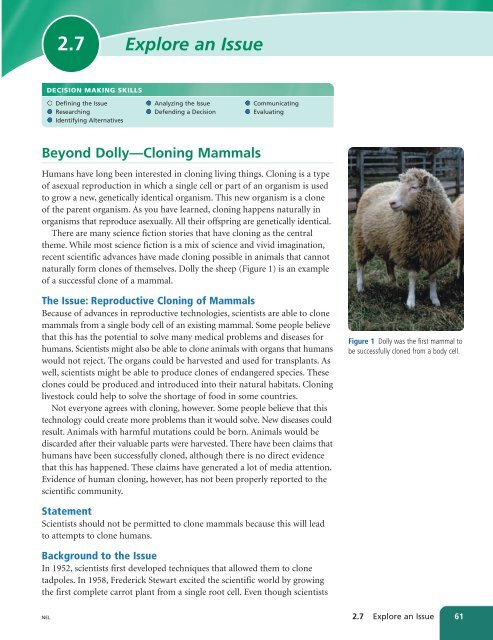Unit A Reproduction
Unit A Reproduction
Unit A Reproduction
Create successful ePaper yourself
Turn your PDF publications into a flip-book with our unique Google optimized e-Paper software.
2.7<br />
Explore an Issue<br />
DECISION MAKING SKILLS<br />
Defining the Issue<br />
Researching<br />
Identifying Alternatives<br />
Analyzing the Issue<br />
Defending a Decision<br />
Communicating<br />
Evaluating<br />
Beyond Dolly—Cloning Mammals<br />
Humans have long been interested in cloning living things. Cloning is a type<br />
of asexual reproduction in which a single cell or part of an organism is used<br />
to grow a new, genetically identical organism. This new organism is a clone<br />
of the parent organism. As you have learned, cloning happens naturally in<br />
organisms that reproduce asexually. All their offspring are genetically identical.<br />
There are many science fiction stories that have cloning as the central<br />
theme. While most science fiction is a mix of science and vivid imagination,<br />
recent scientific advances have made cloning possible in animals that cannot<br />
naturally form clones of themselves. Dolly the sheep (Figure 1) is an example<br />
of a successful clone of a mammal.<br />
The Issue: Reproductive Cloning of Mammals<br />
Because of advances in reproductive technologies, scientists are able to clone<br />
mammals from a single body cell of an existing mammal. Some people believe<br />
that this has the potential to solve many medical problems and diseases for<br />
humans. Scientists might also be able to clone animals with organs that humans<br />
would not reject. The organs could be harvested and used for transplants. As<br />
well, scientists might be able to produce clones of endangered species. These<br />
clones could be produced and introduced into their natural habitats. Cloning<br />
livestock could help to solve the shortage of food in some countries.<br />
Not everyone agrees with cloning, however. Some people believe that this<br />
technology could create more problems than it would solve. New diseases could<br />
result. Animals with harmful mutations could be born. Animals would be<br />
discarded after their valuable parts were harvested. There have been claims that<br />
humans have been successfully cloned, although there is no direct evidence<br />
that this has happened. These claims have generated a lot of media attention.<br />
Evidence of human cloning, however, has not been properly reported to the<br />
scientific community.<br />
Figure 1 Dolly was the first mammal to<br />
be successfully cloned from a body cell.<br />
Statement<br />
Scientists should not be permitted to clone mammals because this will lead<br />
to attempts to clone humans.<br />
Background to the Issue<br />
In 1952, scientists first developed techniques that allowed them to clone<br />
tadpoles. In 1958, Frederick Stewart excited the scientific world by growing<br />
the first complete carrot plant from a single root cell. Even though scientists<br />
NEL<br />
2.7 Explore an Issue 61

















